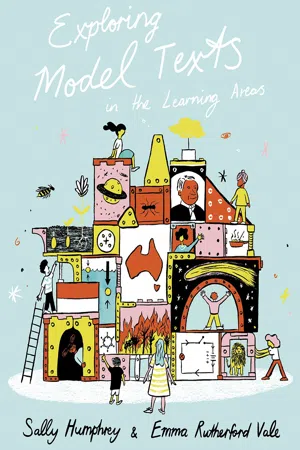Chapter 1
A functional
view of language
In Investigating model texts for learning, we explore meanings in a range of texts composed by or for primary students in Australian schools. To do this we draw on a functional view of language in line with the Australian Curriculum: English, and national and state literacy policies in Australia.
A functional view of language is based on a theory called systemic functional linguistics (SFL), which was originally developed by Halliday (Halliday & Hasan, 1985) and has been extended for educational purposes by linguists working with teachers in Australian schools (Callow, 2013; de Silva Joyce & Feez, 2016; Derewianka & Jones, 2016; Humphrey, 2017; Martin & Rose, 2008). A functional view is particularly useful for teachers because it recognises that language has evolved to get things done – so its terminology and descriptions, which we call a metalanguage, are tools for teachers and students to discuss how writers and composers make choices to get things done with language!
Because a functional approach views language as a system of choices for making meaning, it has significant implications for the way we teach writing. An enduring challenge in the literacy classroom is how to support all students to develop language and literacy skills that enable successful engagement and progression with curriculum learning. Students bring uneven language and literacy repertoires to our classrooms, with individual students varying in their development and control of language resources for different social and school contexts, as well as in their rates of progress. Teachers play a critical role in ensuring that all learners have the expanded language repertoire they need to successfully interpret and compose texts for curriculum learning. This means providing all students with the opportunity to explore choices for meaning-making in texts others have written, including talking about how successful these choices are, as well as speculating about other language choices that could have been made to shape a different text. As students engage with shared reading and writing of model texts, we are expanding their available choices for composing effective texts, and also extending their repertoire for interpretation and critique.
In Investigating model texts for learning, we take a ‘top down’ approach to exploring meaning. Rather than approaching texts as words and phrases ordered in correctly structured sentences, building up to paragraphs and whole texts, we begin by considering the contexts in which they are composed and interpreted, including their overall purposes and their role in curriculum learning. We have selected representative texts from the four areas of English (ENG), Science (SCI), History and Social Sciences (HASS), and Health and Physical Education (HPE) – and made connections to their role in the curriculum. They are called model texts because they have been judged by teachers as being effective texts that represent substantial attainment of curriculum standards, and because they include features of structure and language that are highly valued in the Australian Curriculum: English. As such they are rich models to learn language, to learn through language and to learn about language.
The detailed and comprehensive analysis we include in chapters 2 to 6 draws on SFL’s layered description of context as genre and register. This analysis aims to draw teachers’ attention to the structural and language patterns of the texts from a number of perspectives. We anticipate that teachers will use this analysis to identify a smaller number of features that they would like to model in their own classrooms to meet the particular learning needs and contexts of their students.
Clean copies of the texts are provided as on online resource for teachers to adapt and use in the classroom, or to guide their own work of developing and using model texts (texts available for download at petaa.edu.au).
Genres: Purpose and structure
In Chapter 2 we explore a sample of texts from across the curriculum areas to show how the structure of a text contributes to its unfolding purpose. We use SFL’s theory of genre (Martin & Rose, 2008), which is glossed as ‘the ways people get things done with language in ...



